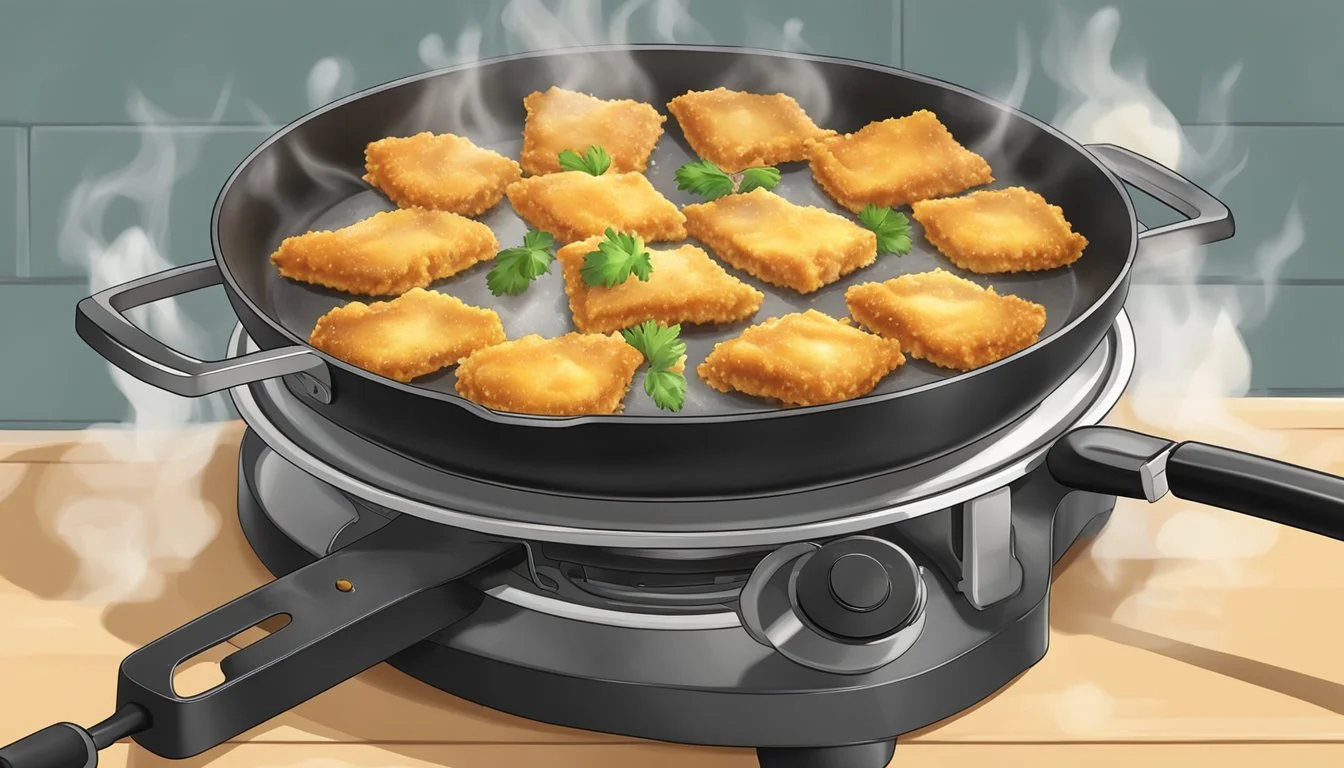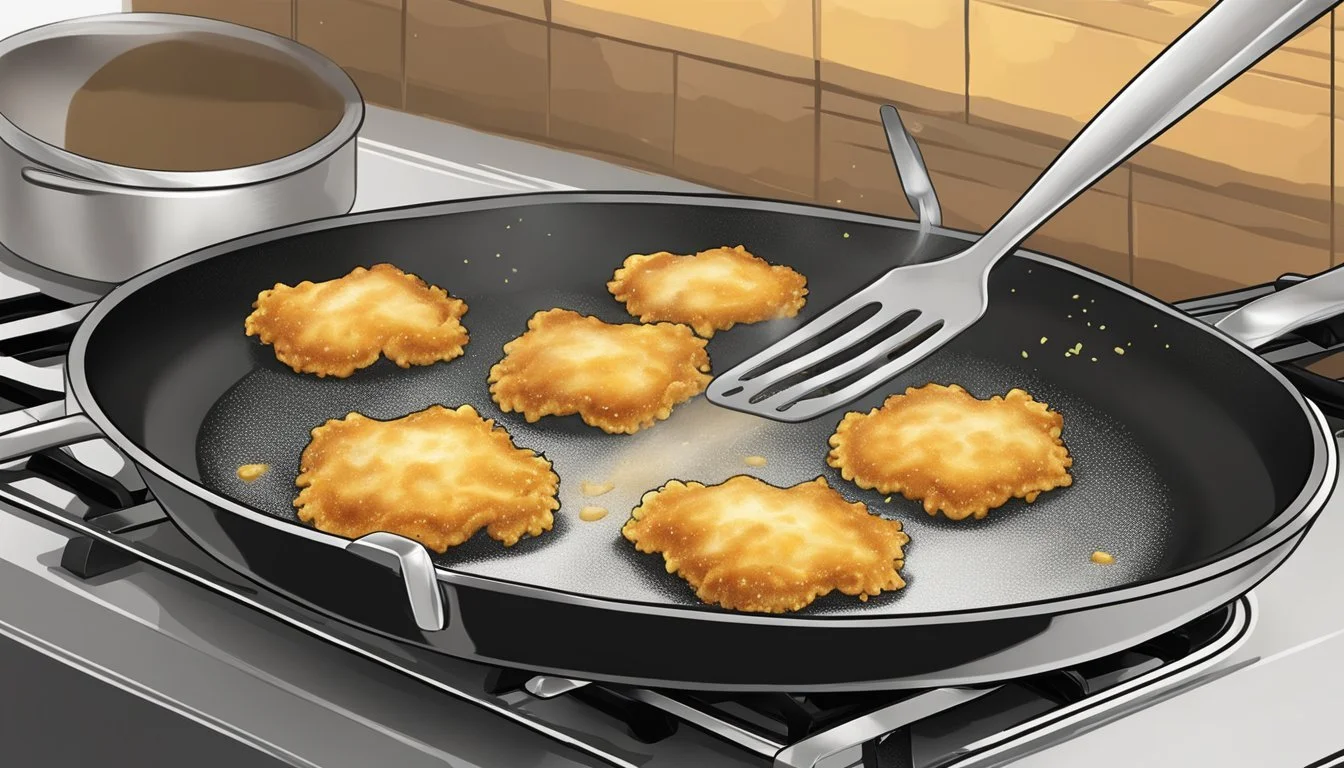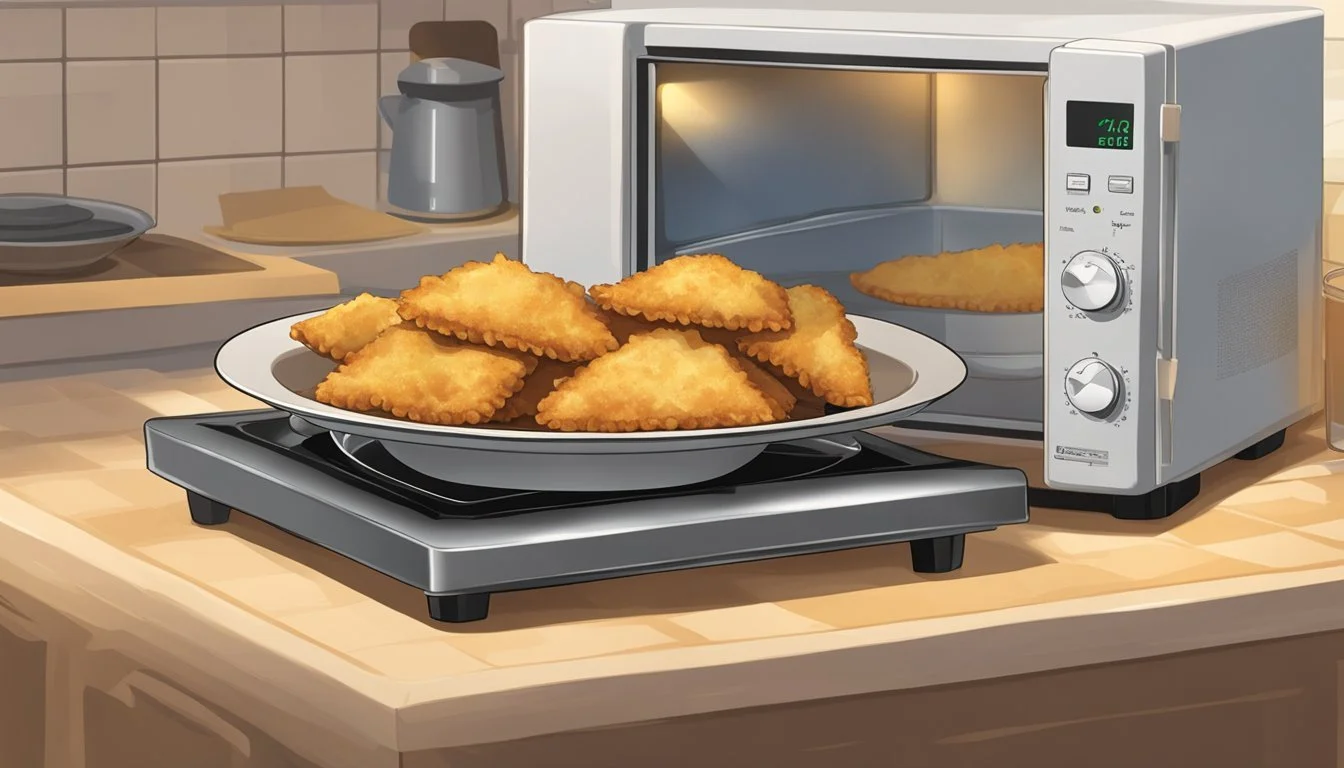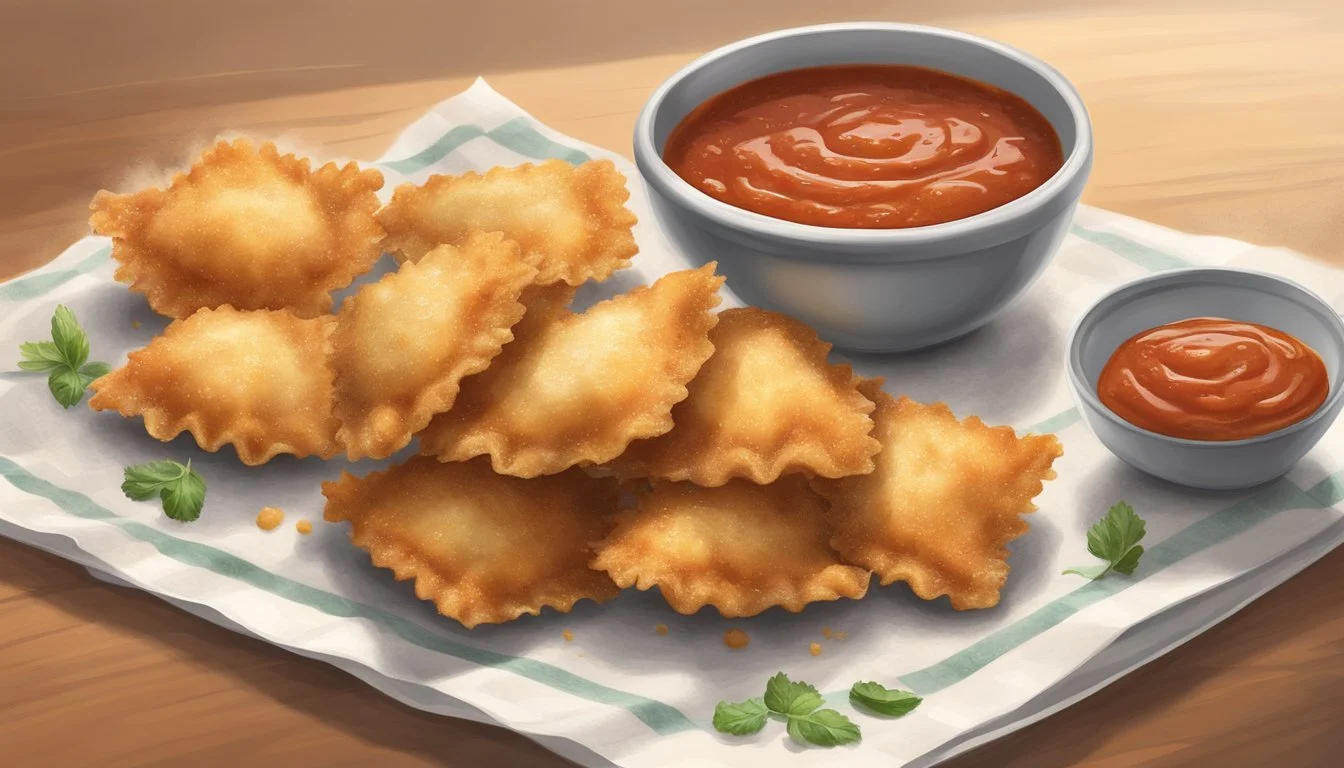Best Way to Reheat Fried Ravioli
Keeping the Crunch Alive
Reheating fried ravioli while preserving its delightful crispiness is a common culinary challenge. The key is to apply a method that restores the warmth without compromising the texture of this popular appetizer. Fried ravioli, known for its crunchy exterior and soft, flavorful filling, demands a reheating technique that can closely mimic its initial post-frying quality.
One effective approach is to use an oven, which circulates heat evenly, avoiding the sogginess that can result from microwave reheating. Preheating the oven to an appropriate temperature, such as 375°F (190°C), and placing the ravioli on a baking sheet can yield ravioli that is crispy on the outside and warm on the inside. Another option is to employ an air fryer, setting it to a similar temperature, which utilizes rapid air circulation to reheat the ravioli efficiently while reinforcing the crispness of its coating.
The stovetop method is also an alternative, where a small amount of oil can be heated in a pan to fry the ravioli until it regains its golden-brown exterior. Each of these methods has the potential to revitalize leftover fried ravioli, turning it into a dish that can once again be served with confidence, boasting a crispy coating that enhances its texture and taste.
Preparation for Reheating
Before reheating leftover fried ravioli, one must ensure that they are prepared properly to maintain their crispiness. Examine the ravioli; they should be stored correctly prior to reheating, ideally in an airtight container to prevent moisture accumulation that could make them soggy.
If the ravioli were frozen, they should be thawed before reheating. This can be done by transferring them from the freezer to the refrigerator several hours before reheating, or for quick thawing, leave them at room temperature for a shorter period. Proper thawing ensures even reheating and helps preserve the texture.
Steps for Preparation:
Storage Check: Confirm that the ravioli were stored in an airtight container.
Inspect: Look for any signs of spoilage before proceeding.
Thawing (if applicable):
Refrigerator: Place the ravioli in the fridge for a few hours.
Room Temperature: Leave out for no longer than 2 hours.
Dryness: Pat them dry with a paper towel to remove any excess moisture, which is crucial to avoid a steamy outcome instead of a crispy one.
Here's a table summarizing the preparation steps for different storage cases:
Storage State Preparation Refrigerated Check dryness, then proceed Frozen & Thawing Thaw completely, pat dry
By adhering to these guidelines, they will ensure that the fried ravioli has the best chance of returning to its original texture and flavor during the reheating process.
Oven Reheating Method
The oven reheating method for fried ravioli combines the right temperature, use of baking tools, and timings to maintain the desired crispiness of the coating.
Setting the Oven Temperature
An essential step in reheating fried ravioli is to preheat the oven. The recommended temperature for achieving optimal crispiness without burning the ravioli is to set the oven at 375°F (190°C). This temperature allows the ravioli to warm through evenly while re-crisping the outer layer.
Using Baking Sheet and Parchment Paper
For even heat distribution, one should use a baking sheet, preferably lined with parchment paper. The parchment paper prevents sticking and ensures the ravioli do not tear when removing them from the baking sheet. Placing ravioli in a single layer without overcrowding is vital for uniform baking and to prevent steam from making them soggy.
Oven Cook Time and Monitoring
The cook time is generally between 10-15 minutes, and it's advisable to flip the ravioli halfway through the cooking process. It's important to keep an eye on them to avoid overcooking. The ravioli are done when they are heated through to an internal temperature of 165°F (74°C), and the exterior is crisp to the touch.
Toaster Oven Technique
Reheating fried ravioli in a toaster oven is an excellent method for preserving its crispiness. The toaster oven provides a smaller, more controlled heating environment compared to a regular oven, helping to restore the ravioli's delightful crunch.
Instructions:
Preheat the toaster oven to 375°F (190°C), ensuring it reaches the desired temperature before placing the ravioli inside.
Arrange the ravioli in a single layer on the toaster oven tray. It is crucial they do not overlap or touch to ensure even heating.
Cook Time:
Condition Time Preheated 6-8 minutes Not Preheated 10-12 minutes
Halfway through the cook time, flip the ravioli to promote even crisping on both sides.
Monitor the ravioli closely, as cook time may vary depending on the toaster oven model and the size and thickness of the ravioli.
The resulting reheated fried ravioli should be hot and crispy, mirroring the texture achieved when they were first cooked. By using a toaster oven, users maintain the integrity of the ravioli's exterior while also ensuring a thoroughly warmed interior. This method is efficient, requiring less energy than reheating with a traditional oven, making it not only effective but also more economical.
Stovetop Method
Using the stovetop to reheat fried ravioli allows one to maintain the crispy exterior that makes them so enjoyable. It involves refrying them in a skillet, which, if done correctly, can restore their fresh-out-of-the-kitchen crunch.
Choosing the Right Skillet
For effective reheating, one must choose the right skillet. A heavy-bottomed pan or cast-iron skillet is ideal because it provides a consistent heat distribution, reducing the chance of uneven cooking or burning. Non-stick pans can be used as well, particularly if one is trying to use less oil.
Oil and Temperature Control
To achieve the optimal crispiness, heat the oil to 350°F (175°C). It's important to use a kitchen thermometer to verify the temperature. Add enough oil to just cover the bottom of the skillet — about a one-quarter inch deep. The consistent heat will assist in evenly warming the ravioli without making them soggy.
Pan-Frying for Crispiness
Once the oil reaches the correct temperature, gently place the ravioli into the skillet in a single layer, ensuring they aren't touching each other. Cook them for about 1-2 minutes on each side until they regain their crisp exterior. After frying, transfer the ravioli onto a plate lined with paper towels to absorb any excess oil.
Air Fryer Reheating
When reheating fried ravioli in an air fryer, the goal is to restore the crispiness of the coating while ensuring the filling heats through. The air fryer, with its compact space and hot circulating air, excels at crisping up the exterior of the ravioli.
Steps for Reheating Fried Ravioli in an Air Fryer:
Preparation: One should preheat the air fryer to 350°F. This ensures the appliance is ready to evenly reheat the ravioli.
Cooking Spray (Optional): Lightly coat the ravioli with cooking spray. This can help achieve a more even and crispy exterior but is not a necessity, as the air fryer naturally excels at crisping food.
Ravioli Placement: Arrange the ravioli in a single layer in the air fryer basket to ensure each piece is exposed to the hot circulating air. Avoid overcrowding to maintain crispiness.
Reheating Time: Heat the ravioli for 3 to 5 minutes. This is a general guideline and can vary based on the size and thickness of the ravioli and individual air fryer models.
Checking Crispiness: At the midway point, roughly after 1.5 to 2.5 minutes, it's recommended to check the ravioli and shake the basket to promote even reheating.
Don'ts Dos Do not over-stack the ravioli. Do shake the basket halfway. Do not set the temperature too high. Do use a cooking spray for extra crisp. Do not leave them unattended for too long. Do check for consistent heating.
Following these steps should result in fried ravioli that is both crispy and warm, much like when it was freshly prepared. Adjustments may be required based on the specific make and model of the air fryer, as well as the initial condition of the ravioli. The key is to monitor closely and adjust the time as necessary.
Microwave Warnings
When reheating fried ravioli in a microwave, it's important to understand that one may not achieve the desired crispiness of the coating. Microwaves reheat food by causing water molecules to vibrate, which generates heat. This method tends to steam the food, which can result in a soggy texture due to moisture retention.
Table 1: Microwave Reheating Challenges
Challenge Description Impact on Ravioli Even Heating Microwaves can heat unevenly, leading to hot and cold spots. Some ravioli may be over or under-reheated. Texture Can cause fried foods to lose crunch. The ravioli may become soft or rubbery. Moisture Control Steam can get trapped, creating moisture. The outer coating may become soggy.
To mitigate these issues, follow these steps:
Spread out the ravioli: Arrange the pieces on a microwave-safe plate without touching.
Cover lightly: Use a microwave-safe lid or a damp paper towel to promote even steam distribution.
Power setting: Reheat at 50% power to reduce the intensity and minimize texture degradation.
Time management: Heat in short bursts, checking regularly to prevent overheating.
While these steps can reduce moisture buildup, the microwave process may still not preserve the crispness of fried ravioli as well as other reheating methods would. If a crispy coating is a priority, one should consider using an oven or air fryer for reheating.
Deep Fryer Reheating
When one chooses to reheat fried ravioli using a deep fryer, the goal is to restore the delectable crispness that makes this dish so appealing. The deep fryer method is ideal for achieving a crisp exterior while ensuring that the ravioli is thoroughly warmed.
Step-by-Step Reheating Process:
Preheat the Oil: Preheat the oil to a steady temperature of 350°F (175°C). Use a kitchen thermometer to monitor the oil's temperature, ensuring accuracy.
Prepare the Ravioli:
Arrange the ravioli on a plate or tray.
Pat them dry to remove any moisture that could cause the oil to spatter.
Fry in Batches:
Gently place a few ravioli into the hot oil.
Do not overcrowd the deep fryer, as this can lower the oil temperature and result in soggy ravioli.
Cook to Perfection: Fry the ravioli until they are golden brown and have regained their crispy texture. This usually takes about 1-2 minutes.
Tips for Best Results:
Use a slotted spoon to carefully lower and remove the ravioli from the oil.
Drain excess oil on a paper towel-lined plate.
Maintain oil temperature between batches by allowing the deep fryer to reheat briefly if necessary.
By following these instructions, one can ensure their fried ravioli will come out as tantalizing and crispy as when they were first made.
Reheating Tips and Tricks
Reheating fried ravioli properly is critical for preserving its desirable crispy coating and robust flavor. The following tips and tricks are aimed at avoiding sogginess and maintaining the dish's texture and flavor during reheating.
Avoiding Sogginess
To prevent fried ravioli from becoming soggy, one must ensure that steam can escape during the reheating process.
Oven method: Preheat the oven to 375°F (190°C). Spread the ravioli in a single layer on a baking sheet. Use a wire rack to elevate them, allowing air circulation on all sides.
Air fryer method: An air fryer set to 350°F (180°C) for 3-5 minutes is ideal for smaller batches. This method uses rapid air circulation to reheat without sogginess.
Here is a visual guide for oven reheating:
Step Action 1 Preheat oven to 375°F (190°C). 2 Arrange ravioli on a wire rack over a baking sheet. 3 Heat for 10-15 minutes, flipping halfway.
Maintaining Texture and Flavor
One can retain the crispy texture and flavor of fried ravioli by following a few additional cooking tips.
Breadcrumb coating: If the ravioli's coat has softened, consider lightly recoating with breadcrumbs before reheating.
Batch size: To ensure even reheating and maintenance of texture, fry or bake ravioli in small batches.
Cooking time: Monitor the ravioli closely to avoid overcooking, which can cause them to dry out and lose flavor.
In summary, reheating involves a delicate balance of temperature, time, and technique. Using these methods, one can enjoy fried ravioli that is as close to freshly prepared as possible.
Serving and Accompaniments
When serving reheated fried ravioli, it's essential to consider the dipping sauces and garnishes to enhance the overall experience. Both elements play a crucial role in balancing flavors and improving presentation.
Best Dipping Sauces
Fried ravioli, typically enjoyed as an appetizer or snack, pairs well with a variety of dipping sauces. Popular choices include:
Marinara Sauce: A classic option, marinara sauce offers a tangy and herbaceous complement to the crispy coating of the ravioli.
Pesto: For a burst of fresh herby flavor, pesto brings together basil, garlic, pine nuts, and Parmesan, which can elevate the ravioli's taste.
Alfredo Sauce: Creamy alfredo sauce makes for a rich and indulgent dip, providing a counterbalance to the ravioli's crispiness.
Garnishing for Presentation
A thoughtful garnish not only adds flavor but also enhances the visual appeal of the dish. Consider the following:
Fresh Parsley: A sprinkle of chopped fresh parsley can introduce a fresh taste and a pop of color.
Grated Cheese: A light dusting of freshly grated Parmesan or pecorino cheese lends a salty, savory element and a touch of elegance.
Proper garnishing turns the reheated fried ravioli into a visually appealing dish that invites diners to dig in.
Healthier Alternatives
When reheating fried ravioli, one can opt for methods that reduce caloric intake without compromising on taste. Oven reheating stands out as a healthier alternative to deep frying. By preheating the oven to 375°F and baking the ravioli on a lined baking sheet for approximately 10-15 minutes, they achieve a desirable crispness with significantly less oil.
Using an air fryer can also offer a reduction in calories. Set the air fryer to 350°F and warm the ravioli for 3-5 minutes. It utilizes hot air circulation to recreate the crispy texture with minimal oil usage.
For those seeking gluten-free options, attention should shift to the ravioli's coating. Opting for gluten-free breadcrumbs for the initial preparation ensures that the reheating process maintains that dietetic consideration.
Nutritional information is also paramount. The choice of filling can affect the overall nutritional value. Fillings rich in protein and vegetables as opposed to cheeses or processed meats can offer more balanced nutrients.
Key Points:
Oven Reheating: 375°F for 10-15 minutes, less oil required.
Air Fryer: 350°F for 3-5 minutes, minimal oil.
Gluten-Free Breadcrumbs: For gluten-free concerns, use appropriate breadcrumbs.
Healthy Fillings: Choose protein and vegetable-based fillings for improved nutrition.
Each alternative method has its own way of supporting a healthier lifestyle while enjoying the satisfying crunch of reheated fried ravioli.
Understanding Fried Ravioli
Fried ravioli is a delectable dish known for its crispy coating and the variety of fillings it can encompass. It stands as a testament to culinary innovation and cultural fusion.
Origin and Popularity
Fried ravioli is believed to have originated in St. Louis, Missouri, becoming a staple appetizer in the region. It is often associated with Italian-American cuisine and has gained popularity across the United States. This dish is traditionally served as a finger food with a side of marinara sauce, which complements its crispy exterior and rich filling.
Ravioli Varieties
There are numerous types of fillings found in fried ravioli, catering to diverse palates. The most common types include:
Cheese-Filled Ravioli: A favorite for those who prefer a creamy and melted cheese center.
Meat Ravioli: Often filled with seasoned beef, pork, or a combination of meats, offering a hearty flavor.
Vegetarian Option: Includes fillings like spinach and ricotta or a medley of vegetables for those seeking a meat-free option.
For a personalized touch, homemade ravioli can be crafted with customized fillings, ensuring that the flavors align with individual preferences. The process of breading and frying transforms the ravioli from a typical pasta dish to a sought-after crispy delicacy.
Making Fried Ravioli at Home
Home cooking allows the flexibility to choose between crafting ravioli from scratch with a choice of fillings like spinach and ricotta or meat, or opting for the convenience of frozen ravioli. Either path leads to a delicious, crispy outcome when prepared with attention to detail and the right ingredients.
Preparation and Ingredients
Before beginning the cooking process, it’s important to gather all the necessary ingredients:
Ravioli: Choose either homemade ravioli stuffed with a cheese or meat filling or select high-quality frozen ravioli.
Breading Mixture:
Breadcrumbs: Essential for the crispy exterior.
Flour: A dusting of flour helps the egg wash adhere to the ravioli.
Eggs: Beaten eggs create a sticky base for the breadcrumbs.
Italian Seasoning, Garlic Powder, and Parsley: These herbs enhance the flavor profile.
Salt: To taste.
Frying:
Olive oil: For pan-frying, ensuring ravioli are golden and crisp.
Step-by-Step Cooking Process
Prep Time: Set aside enough time for preparation—this includes breading and frying. Homemade ravioli will require additional prep time.
Prepare the Breading Station: Put flour, beaten eggs, and breadcrumbs mixed with Italian seasoning, garlic powder, parsley, and salt into three separate shallow dishes.
Breading:
Lightly coat the ravioli in flour, shaking off any excess.
Dip into the beaten eggs, allowing excess to drip off.
Press into the breadcrumbs until thoroughly coated.
Frying:
Heat olive oil in a deep frying pan to approximately 350°F (175°C).
Carefully lower the breaded ravioli into the hot oil without overcrowding.
Cook until they achieve a golden-brown color, being attentive to not overcook, which typically takes a few minutes.
By following these steps, one produces home-cooked fried ravioli with a satisfying crispy exterior and succulent filling, surely to rival any restaurant offering.
Creative Recipes and Twists
When reheating fried ravioli, one doesn't have to stick to the original flavor profile; they can explore various culinary enhancements to elevate the dish. Introducing creative twists not only rejuvenates the dish but also provides a novel culinary experience.
Cheese Lover's Delight: One can sprinkle a blend of Parmesan and mozzarella cheeses over the ravioli before the final few minutes of reheating in the oven. This creates a delightful cheese pull and enhances the flavor.
Herb Infusion: During the reheating process, they can infuse the oil with aromatic herbs like rosemary or thyme to subtly flavor the ravioli, adding a new dimension to the dish.
Dipping Sauces:
Classic Marinara: A fresh, herby tomato sauce complements the crispiness of the ravioli.
Creamy Pesto: For a richer taste, a basil pesto mixed with cream offers a lush alternative.
Spicy Aioli: Those who favor a kick could whisk together mayonnaise, garlic, lemon, and chili flakes.
Asian Twist: They can glaze the ravioli with a mixture of soy sauce, honey, and a dash of sesame oil before air frying. This imparts an East Asian influence that's tantalizingly different.
Component Suggestion Benefit Cheese Mix of Parmesan and mozzarella Richness and depth of flavor Herbs Rosemary or thyme during reheating Aromatic enhancement Dipping Sauce Variety (Marinara, Pesto, Aioli) Complementary flavors and textures Glaze Soy, honey, sesame mixture Adds an unconventional twist
By branching out with these creative recipes and twists, one can revitalize their reheated fried ravioli and indulge in an enriched taste profile that is sure to impress.
Nutritional Guide and Considerations
When reheating fried ravioli, it's important to consider the nutritional implications, particularly concerning caloric intake and nutritional content. Fried ravioli is typically high in calories due to the breading and frying process. Those monitoring their calorie consumption should be aware that reheating this dish does not change its initial caloric value.
Caloric Information: A standard serving of fried ravioli can vary in calories, but one can expect it to range within 200-400 calories. The exact number depends on the ingredients used, such as types of filling and the amount of breading.
For individuals adhering to a gluten-free diet, fried ravioli poses a challenge as traditional recipes include wheat-based breading. Gluten-free diners should seek out ravioli made with gluten-free substitutes or consider making homemade ravioli using gluten-free breadcrumbs or flours.
Nutritional Content: Apart from calories, fried ravioli provides certain nutritional benefits like protein from the cheese or meat filling. However, it is also important to recognize that this dish can be high in fats and carbohydrates.
Nutrient Approximate Amount per serving Calories 200-400 kcal Protein 10-20 g Fat 10-25 g Carbohydrates 20-40 g
The addition of ingredients like flaxseed can enhance the nutritional profile. Flaxseed is known for its high fiber, omega-3 fatty acids, and lignan content, which can benefit heart health and digestion. When incorporating flaxseed into the breading, it not only adds a nutty flavor but also boosts the health benefits of the dish.
Additional Resources
This section provides valuable resources for those seeking visual guidance and expert advice on reheating fried ravioli. It includes links to video tutorials that demonstrate the reheating process and a compilation of tips from culinary experts.
Video Tutorials
For visual learners, video tutorials are a practical way to understand the reheating process. Viewers can find step-by-step walkthroughs on:
YouTube, where chefs share their methods for reheating fried ravioli in a way that preserves its crispiness.
Cooking blogs and websites often feature video sections where professional cooks demonstrate reheating techniques in a kitchen setting.
Expert Cooking Tips
Culinary experts offer a wealth of knowledge that can enhance the quality of reheated fried ravioli:
Temperature control: Experts stress the importance of heating oil to the right temperature (around 350°F) before adding the ravioli to avoid sogginess.
Batch size: Cooking in small batches prevents overcrowding and ensures each ravioli reheats evenly.
Alternative methods: For those without a deep fryer, using an oven or air fryer at specified temperatures can yield similar crispy results.
By utilizing these resources, one can master the art of reheating fried ravioli, maintaining its desirable crispy texture.









